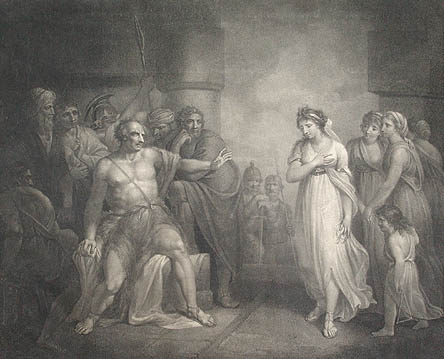| Title: |
Samson and Delilah |
| Engraver: |
Bond, William (London, c. 1750 - 1809) |
| Designer: |
Singleton, Henry (London, 1766 - 1839) |
| Date: |
c. 1790 |
| Medium: |
Original Stipple Engraving |
| Note: |
William Bond: Like most of the great eighteenth
century stipple engravers, William Bond studied under Bartolozzi. His
first engraved work of art was published in 1772, and he continued to
create engravings until 1807. During the latter part of the century William
Bond was considered to be among the greatest stipple engravers, along
with Richard Earlom, John Ogborne and Charles Turner. William Bond also
had the distinction of being nominated the first President of the Society
of Engravers when it was founded in 1803. |
| |
Samson and Delilah is listed as one of William
Bond's greatest works of art and is based upon a design created by the British
artist, Henry Singleton.* It is composed entirely of stippling
and expresses a huge range of beautifully delineated tonal values. The
scene depicts Samson moments before his final, fatal act. It will be
recalled that Samson was the Israelite leader in the struggle against
the then dominant Philistines. Graced with almost superhuman strength,
Delilah seduced him and gained the secret of his powers. While he slept,
she had his hair shaved off. His strength gone, the Philistines arrested
Samson and blinded him. During a feast in the Temple of Dagon, his captors
brought Samson out of his prison to make sport of him. (The artist has
here depicted this scene with Delilah expressing silent remorse for her
cruel act.) However, Samson's hair had grown back, and praying to God
for his power, he pulled down the supporting columns thus killing himself
and destroying more than three thousand Philistines. (Ian Mackenzie, British
Prints: Dictionary and Price Guide, Antique Collectors' Club, Suffolk,
1987, p. 57.) |
| |
Stipple Engraving: When the famous Italian
engraver, Francesco Bartolozzi (Florence, Italy, 1727 - Lisbon, Portugal, 1815), came to
settle permanently in England in 1764 he brought with him a new technique
of engraving that would dominate British art through the last two decades
of the eighteenth century. This was the golden era of the 'stipple' engraving.
Briefly, a stipple engraving was created by employing masses of flicks
and dots rather than solid lines, making it a tonal method. Stippling
was best suited for capturing the delicate tones within figure compositions.
Unfortunately it became all but obsolete by the first decade of the nineteenth
century because the technique was very complex and time consuming. |
| Size: |
16 3/4 X 20 1/2 (Sizes in inches are approximate,
height preceding width of plate-mark or image.) |
| |
Matted with 100% Archival Materials |
| Condition: |
Printed upon late eighteenth century wove paper and with
margins trimmed to the image. Containing marginal damage along the extreme
edges, particularly to the lower left corner. As well, several restored
scrapes are within the image. Otherwise, this is a very early impression
bearing all the fine shades and tones of an initial printing. One should
here take note that this engraving in fine condition has sold at auction
for over $1,000. "Samson and Delilah" is a superb, original example of
the talents of William Bond and of the art of the eighteenth century
British stipple engraving. |
| Price: |
Sold - The price
is no longer available. |
| Important Information: |
The artist biographies, research and or information pertaining to all the original works of art posted on our pages has been written and designed by Greg & Connie Peters exclusively for our site, (www.artoftheprint.com). Please visit us regularly to view the latest artworks offered for sale. We will soon be posting an update of our most recent research and include the biographical and historical information pertaining to our next collection of original works of art created by artists throughout the centuries. We hope you found the information you were looking for and that it has been beneficial.
Our Gallery, (Art of the Print / www.artoftheprint.com) guarantees the authenticity of every work of art we sell 100%. Full documentation and certification is provided. We offer a wide selection of international fine art dating from the early Renaissance to the contemporary art period. |




![]()
![]() or
phone Greg & Connie (905) 957-6666
or
phone Greg & Connie (905) 957-6666